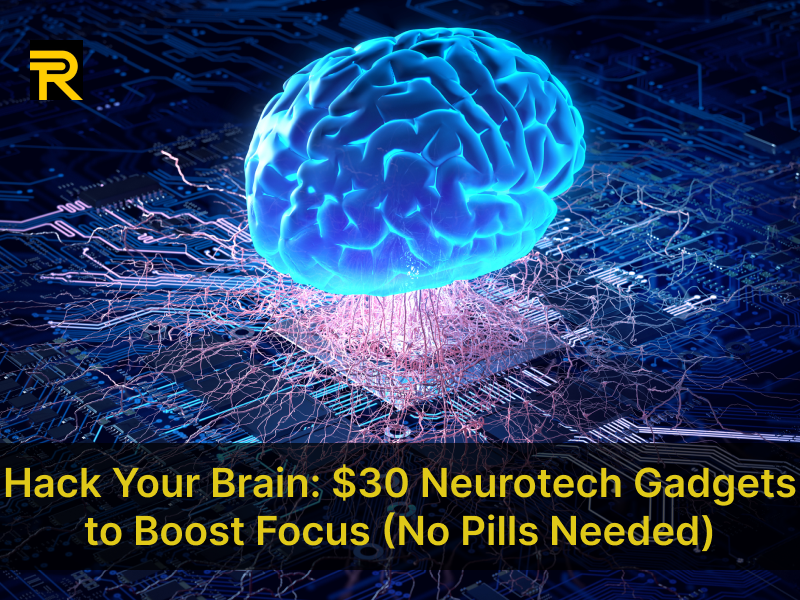
Hack Your Brain: $30 Neurotech Gadgets to Boost Focus (No Pills Needed)
Hack Your Brain: $30 Neurotech Gadgets to Boost Focus (No Pills Needed)
In today’s fast-paced world, maintaining focus and productivity can be a challenge. While some turn to pills or caffeine, there’s a growing trend of using neurotechnology to enhance cognitive performance. From DIY tDCS devices for concentration to CES 2024 award-winning neurotech wearables, affordable brain-hacking gadgets are revolutionizing how we think, work, and learn.
In this article, we’ll explore how you can boost your focus with $30 neurotech gadgets, compare Muse vs Neurosity brain-sensing bands, and even learn how to build a DIY neurofeedback rig. Let’s dive into the future of brain optimization!
Why Neurotech? The Science Behind Brain Hacking
Neurotechnology leverages advancements in neuroscience to improve brain function. Tools like DIY tDCS devices for concentration and EEG headbands use electrical stimulation or brainwave monitoring to enhance focus, memory, and creativity.
These gadgets are not only affordable but also non-invasive, making them accessible to anyone looking to improve their cognitive performance without relying on pills or supplements.
DIY tDCS Devices for Concentration
Transcranial Direct Current Stimulation (tDCS) is a technique that uses low electrical currents to stimulate specific brain regions. Here’s how you can create DIY tDCS devices for concentration:
-
Gather Materials:
-
A 9V battery
-
Electrodes and wires
-
A current-limiting resistor
-
-
Build the Circuit:
-
Connect the battery to the electrodes via the resistor to control the current.
-
-
Apply the Electrodes:
-
Place the electrodes on your scalp, targeting areas like the prefrontal cortex for focus enhancement.
-
While DIY tDCS devices for concentration are cost-effective, it’s important to understand the risks of at-home transcranial stimulation, such as improper current application or skin irritation. Always research thoroughly and proceed with caution.
CES 2024 Award-Winning Neurotech Wearables
The Consumer Electronics Show (CES) 2024 showcased groundbreaking neurotech innovations. Here are some CES 2024 award-winning neurotech wearables to watch:
-
FocusBand: A wearable headband that uses EEG to monitor brain activity and provide real-time feedback.
-
Neurable: A headset that translates brainwaves into actionable insights for productivity.
-
BrainCo: A device that combines EEG and AI to optimize focus and relaxation.
These wearables are perfect for those who want a plug-and-play solution to boost focus and productivity.
Muse vs Neurosity Brain-Sensing Bands
When it comes to brain-sensing wearables, two popular options are Muse vs Neurosity brain-sensing bands. Here’s a comparison:
-
Muse:
-
Pros: Affordable, user-friendly, and great for meditation and focus.
-
Cons: Limited to EEG monitoring and basic feedback.
-
-
Neurosity:
-
Pros: Advanced brainwave analysis, customizable feedback, and developer-friendly.
-
Cons: Higher price point and steeper learning curve.
-
Choose Muse for beginners and Neurosity for tech enthusiasts or developers.
ADHD Focus Hacks with EEG Headbands
For individuals with ADHD, maintaining focus can be particularly challenging. ADHD focus hacks with EEG headbands offer a promising solution:
-
Real-Time Feedback: EEG headbands provide instant feedback on your focus levels, helping you stay on track.
-
Gamification: Many devices use games or challenges to make focus training engaging.
-
Customizable Alerts: Set reminders or alerts to refocus when your attention drifts.
These tools can be life-changing for anyone struggling with ADHD or attention issues.
How to Build a DIY Neurofeedback Rig
If you’re a tech enthusiast, you might enjoy how to build a DIY neurofeedback rig. Here’s a step-by-step guide:
-
Gather Components:
-
EEG headset (e.g., OpenBCI)
-
Microcontroller (e.g., Arduino or Raspberry Pi)
-
Software for data analysis (e.g., OpenViBE)
-
-
Set Up the Hardware:
-
Connect the EEG headset to the microcontroller.
-
-
Develop the Software:
-
Use open-source tools to visualize and analyze brainwave data.
-
-
Create Feedback Mechanisms:
-
Design visual or auditory cues based on brain activity.
-
This project is perfect for hobbyists or those interested in hackathon-winning BCI projects.
Risks of At-Home Transcranial Stimulation
While neurotech gadgets offer exciting possibilities, it’s important to be aware of the risks of at-home transcranial stimulation:
-
Improper Use: Incorrect electrode placement or current levels can cause discomfort or harm.
-
Lack of Regulation: Many DIY devices are not FDA-approved, so proceed with caution.
-
Skin Irritation: Prolonged use of electrodes can irritate the scalp.
Always consult a professional before experimenting with brain stimulation techniques.
Brainwave Apps That Sync with Notion
For productivity enthusiasts, brainwave apps that sync with Notion can be a game-changer. Here are some top options:
-
Brain.fm: Generates music tailored to your brainwaves for focus or relaxation.
-
Focus@Will: Combines neuroscience and music to boost productivity.
-
Notion Integrations: Use APIs to sync brainwave data with your Notion workspace for personalized productivity tracking.
These apps make it easy to integrate brain optimization into your daily workflow.
Amazon’s New "Productivity Helmet" Leaks
Rumors are swirling about Amazon’s new "productivity helmet" leaks. While details are scarce, early reports suggest it will combine tDCS, EEG, and AI to enhance focus and creativity.
If true, this could be a game-changer for the neurotech industry, offering a high-tech solution for productivity enthusiasts.
Neuroplasticity Games for Programmers
Programmers can benefit from neuroplasticity games for programmers, which are designed to improve cognitive flexibility and problem-solving skills. Here are some examples:
-
Lumosity: Offers brain-training games tailored to specific cognitive skills.
-
Peak: Features games that challenge memory, attention, and mental agility.
-
Elevate: Focuses on improving focus, processing speed, and analytical skills.
These games are perfect for programmers looking to sharpen their minds and stay ahead in their field.
Hackathon-Winning BCI Projects
Brain-Computer Interface (BCI) technology is advancing rapidly, with many hackathon-winning BCI projects pushing the boundaries of what’s possible. Here are some inspiring examples:
-
Mind-Controlled Prosthetics: Projects that enable users to control robotic limbs with their thoughts.
-
Brainwave Art: Tools that translate brain activity into visual art.
-
Focus-Enhancing Apps: Apps that use BCI to help users achieve a flow state.
These projects showcase the potential of neurotech to transform lives and industries.
Conclusion
Neurotechnology is no longer confined to labs or expensive medical devices. With DIY tDCS devices for concentration, CES 2024 award-winning neurotech wearables, and brainwave apps that sync with Notion, you can hack your brain for better focus and productivity without spending a fortune.
Whether you’re exploring ADHD focus hacks with EEG headbands or building a DIY neurofeedback rig, the possibilities are endless. Just remember to be mindful of the risks of at-home transcranial stimulation and always prioritize safety.
So why wait? Start exploring the world of neurotech today and unlock your brain’s full potential!
Follow Us
Trending News
Newsletter
Join us to get latest News Updates



